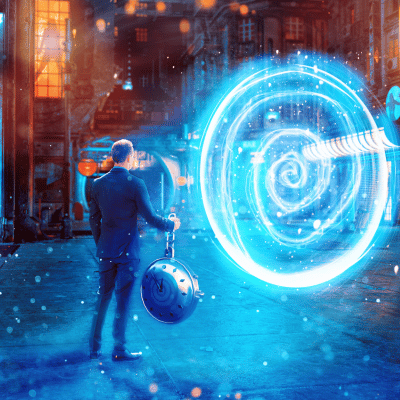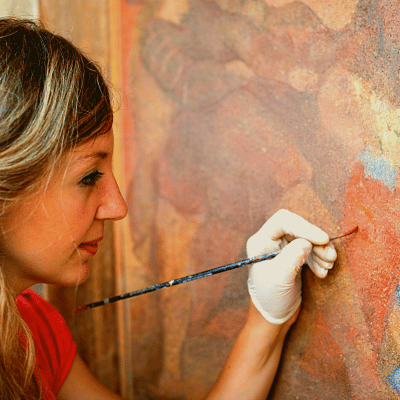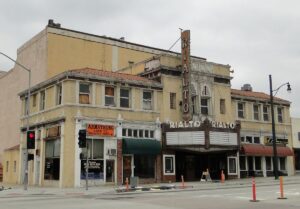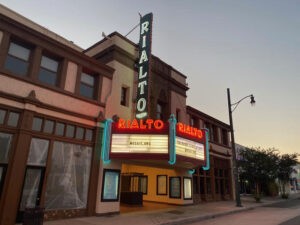In a world where the new and shiny often take center stage, the allure of vintage signs remains timeless. Sign restoration is an art form that marries history with craftsmanship, breathing new life into relics of the past. Through antique sign restoration, these venerable emblems are not only preserved but are also given a chance to reclaim their former glory. Whether it’s an old neon sign from a 1950s diner or a weathered wooden board from a century-old general store, restoring these signs is akin to opening a treasure chest of stories and memories.
In this blog post, we will delve into the captivating world of sign restoration and explore how this craft is keeping the spirit of vintage signs alive for future generations. So, let’s turn back the clock and embark on a journey through time with these magnificent pieces of history.
The Time Travelers: How Restored Signs Transport Us Back in Time

There’s something almost magical about standing in front of a beautifully restored antique or vintage sign.
Through sign restoration, these pieces, often made of sturdy metal, become portals to bygone eras. Imagine a vintage sign from an old soda pop shop or a classic movie theater marquee; they evoke a sense of nostalgia and wonder, as if one could step through them and find themselves in another time. The painstaking restoration of the paint, the polishing of the metal signs, and the careful preservation of every detail are akin to piecing together a historical puzzle.
Each vintage sign has its own story to tell, from the hands that crafted it to the countless eyes that have gazed upon it. Sign restoration is not just about refurbishing an object; it’s about rekindling the soul of an era and inviting others to take a step back in time through the gateway of a vintage sign.
The Alchemist’s Touch: Turning Rusty Metal into Gold with Sign Restoration
In the realm of sign restoration, the restoration team are the modern-day alchemists. With skilled hands and a wealth of knowledge, they transform rusty, forgotten relics into beautiful old signs that are worth their weight in gold. The process is nothing short of magical. An antique sign, which might have been languishing in an old barn or gathering dust in an attic, is brought into the workshop. Here, the restoration team meticulously works to remove layers of rust, repair any damage, and recreate the original colors and designs.
The transformation is astonishing. What was once a piece of scrap metal becomes a vibrant and cherished piece of history. These beautiful signs, once restored, not only become valuable collectibles but also serve as a testament to the craftsmanship and history they embody. Through the alchemist’s touch of the restoration team, these signs are given a new lease on life, ready to enchant future generations.
Signs of Change: How Restoration Reflects the Evolution of Design Trends
Sign restoration is not just about bringing an antique or vintage sign back to life; it’s also a window into the evolution of design trends. As the restoration process peels back the layers of time, it reveals the original design and the aesthetic sensibilities of the era in which the sign was created. From the ornate and elaborate designs of the early 20th century to the sleek and minimalist styles of the mid-century modern era, each restored sign is a snapshot of sign making history.

Moreover, sign restoration often involves the delicate balance of maintaining the original design while ensuring that the sign is functional and aesthetically pleasing in a modern setting. This often leads to creative fusion, where elements of contemporary design are seamlessly integrated with the sign’s original features. The end result is beautiful vintage signs that not only celebrate their rich history but also resonate with today’s design sensibilities. Through sign restoration, these timeless pieces become living examples of how design trends have evolved, and continue to evolve, over the years.
The Unsung Heroes: Materials and Tools that Make Sign Restoration Possible
In the world of sign restoration, while the beautifully restored signs often steal the spotlight, the materials and tools used in the process are the unsung heroes that make it all possible. Sign restoration is a delicate art that spans many eras, and each era has its unique materials and construction techniques. To achieve a full restoration, it’s essential to use materials that are authentic to the period in which the sign was created. From classic enamels and vintage-style bulbs to specialized metal alloys, the choice of materials is crucial in preserving the integrity of the sign.
Additionally, the tools used in sign restoration are equally important. Skilled craftsmen employ a range of tools, from traditional hand tools for delicate work to modern equipment that allows for precision restoration. These materials and tools work in harmony to breathe new life into signs from bygone eras, ensuring that each piece is not only visually stunning but also true to its historical roots. Through the dedicated work of craftsmen and the unsung heroes of materials and tools, sign restoration continues to preserve and celebrate the rich tapestry of our past.
Aesthetic Alchemy: The Role of Color and Typography in Sign Restoration
Antique sign restoration is an intricate process that goes beyond repairing and cleaning; it’s an aesthetic alchemy that transforms a faded relic into a vibrant piece of art. One of the most critical aspects of this transformation is the restoration of color. Over time, the original colors of an antique sign can fade or peel away, losing their luster. A fresh coat of paint, carefully matched to the original hues, can work wonders in bringing the sign back to life. However, it’s not just about slapping on some paint; it’s about understanding the historical context of the colors and how they were used during the sign’s era.
Typography: The Vital Element
Another vital element in the aesthetic alchemy of antique sign restoration is typography. The fonts and lettering styles used in an antique sign are often indicative of the time period in which it was created. Restoring the typography to its original form is essential in preserving the sign’s historical authenticity. This often involves meticulous hand-painting or crafting of letters to match the original styles. Together, the restoration of color and typography play a pivotal role in the overall aesthetic of the restored sign. They are the ingredients in the alchemical process that not only restore an antique sign to its former glory but also reestablish its connection to the past. Through this aesthetic alchemy, antique sign restoration becomes a labor of love that celebrates history, art, and craftsmanship.
From Ghost Signs to Showpieces: Unearthing Hidden Gems Through Restoration
Ghost signs, those faded and often forgotten advertisements painted on the sides of old buildings, are like whispers from the past. They often go unnoticed, their messages slowly disappearing with time. However, when the decision is made to restore these signs, something magical happens. Through careful cleaning, repainting, and sometimes even reconstruction, these ghost signs are transformed into vibrant showpieces. Not only do they become visually striking, but they also serve as a connection to the history and heritage of the area.
For businesses, restoring ghost signs can have a multitude of benefits. Firstly, a beautifully restored sign can become a landmark, attracting both locals and tourists. This, in turn, can increase foot traffic and visibility for the business. Additionally, by restoring signs that have historical significance, businesses can create a sense of community and pride among residents. It shows an investment in not just the business but also in the preservation of local history and culture. Through the restoration and repainting of ghost signs, businesses can unearth hidden gems that serve as both an homage to the past and a beacon for the future.
The Ripple Effect: How Restoring a Single Sign Can Revitalize an Entire Street
When a sign is restored and repaired, it doesn’t just breathe new life into a single building; it can create a ripple effect that revitalizes an entire street. A beautifully restored sign can be a catalyst for change. It can inspire neighboring businesses to take a second look at their own signage and consider the impact it has on the street’s appearance and atmosphere. As more and more businesses begin to restore and repair their signs, the street transforms into a vibrant and inviting space. This, in turn, can attract more visitors, boost local commerce, and foster a sense of community pride.
Investment For Business Owners
For business owners who are considering sign restoration, it’s worth noting that the investment can have far-reaching benefits beyond their own storefront. By taking the initiative to restore a sign, they can be the spark that ignites positive change in the neighborhood. Many restoration companies offer a free quote, making it easy for business owners to explore the options available to them. Through collective efforts in sign restoration, a street that was once overlooked can become a destination, and a community that was disconnected can find common ground in the shared appreciation of their revitalized surroundings.
Sign Language: Telling Stories Through the Art of Sign Restoration
Signs are more than just displays; they are storytellers. Through the art of sign restoration, a company can bring these stories to life, creating a connection between the past and the present. A restored sign can evoke memories and emotions, and can also educate and inform. For instance, a vintage soda shop sign, once restored, can transport customers back to the days of soda fountains and jukeboxes. It’s not just about advertising a product; it’s about creating an experience. Through the colors, typography, and design, a sign speaks a language that can be fun, nostalgic, or even inspiring.

For a company, embracing the art of sign restoration as a means of storytelling can have a profound impact on how the brand is perceived. It can create a sense of authenticity and depth that modern signage might not capture. Moreover, it can make the company stand out, as the restored sign becomes not just a display, but a conversation piece. Customers are not just walking into a store; they are walking into a story. Through the fun and engaging language of restored signs, companies can create memorable experiences for their customers, build stronger connections with the community, and celebrate the rich tapestry of history that their signs represent.
Conclusion
In conclusion, sign restoration is an art form that goes far beyond the physical act of repairing and refurbishing. It’s a journey through time, a preservation of history, and a celebration of craftsmanship. Through the restoration of vintage signs, we not only revive the beauty of these pieces but also the stories and memories they hold. From the aesthetic alchemy of colors and typography to the ripple effect that can revitalize entire streets, sign restoration has the power to touch lives and communities in meaningful ways.
As we have explored in this blog post, the process of sign restoration is meticulous and requires a delicate balance between preserving the past and embracing the present. It’s a labor of love that brings together artisans, historians, businesses, and communities. Whether you are a business owner considering restoring your signage, or a history enthusiast with a passion for preservation, there is no denying the magic and impact of sign restoration.
So, the next time you come across a beautifully restored sign, take a moment to appreciate the hands that brought it back to life, the history it represents, and the stories it continues to tell. In a world that’s always looking forward, sign restoration is a reminder of the beauty and wisdom in looking back.




